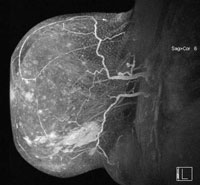- How Breast MRI is Performed
- Benefits of an MRI Exam of the Breast
- Limitations to an MRI Exam of the Breast
While MRI has significant promise as a supplemental tool to mammography in the diagnosis of breast cancer, there are limitations associated with MRI. First, MRI cannot always distinguish between cancerous and non-cancerous abnormalities, which can lead to unnecessary breast biopsies. Another drawback of breast MRI is that has historically been unable to effectively image calcifications, tiny calcium deposits that can indicate breast cancer. However, MRI technology is improving in this area. Still, mammography can reliably image calcifications, which are often associated with early-stage breast cancers such as ductal carcinoma in situ (DCIS).
Another drawback of breast MRI is that has historically been unable to image calcifications, tiny calcium deposits that can indicate breast cancer. Mammography, on the other hand, can reliably image calcifications, which are often associated with early-stage breast cancers such as ductal carcinoma in situ (DCIS).

MRI image showing DCIS. Image courtesy of Siemens Medical.
Another potential drawback of MRI is that it has been shown to produce a moderate amount of false-positive results. In other words, the results of an MRI sometimes show that a suspicious abnormality is present in the breast when, in fact, cancer is not present. To some degree, all medical tests tend to lose some of their value when used in populations where the disease is not common.
Furthermore, MRI is an expensive exam; an average MRI of the breast costs approximately $1000 versus $100 per screening mammogram. MRI can also take longer than mammography: more than 30 minutes in addition to the administration of the contrast versus 10 to 15 minutes for a screening mammogram. Patients need to lie still in a prone (face down) position during the exam to eliminate motion in the images. Though an MRI exam is not painful, patients must tolerate any claustrophobia (fear of small spaces) they may have. A contrast agent is also given prior to the exam to improve image quality.
Finally, MRI is not nearly as widely available as mammography. However, access is increasing, and breast MRI is the second fastest growing MR procedure in the United States. In 2004, 24% of all facilities offering MR services offered breast MRI. According the Advisory Board, by 2010, an estimated 860,000 breast MR procedures will be performed.
Limitations of Breast MRI
- MRI takes 30-60 minutes compared to 10-20 minutes for screening mammography
- The cost of MRI is several times the cost of mammography
- MRI requires the use of a contrast agent
- MRI patients must tolerate any claustrophobia
- MRI can be non-specific; often cannot distinguish between cancerous and non-cancerous tumors
- Minimally invasive breast biopsy techniques need to be further developed to evaluate abnormalities detected with MRI
To summarize, when used in conjunction with mammography, breast MRI can be a very useful breast cancer diagnostic tool. In particular, MRI as been shown to effectively image the augmented breast. MRI can be used effectively to gain information about breast abnormalities detected with mammography, physical exam, or other breast imaging modalities. Because of the increased sensitivity of MRI, the American Cancer Society recently recommended that young women at very high risk of the disease receive annual MRI exams in addition to annual mammograms. MRI may also useful for women diagnosed with breast cancer to detect cancer in the opposite breast, evaluate treatment options, and follow-up after treatment has been completed.
While breast MRI is an effective in some cases, it has limitations that prevent physicians from using it as a widespread screening tool for breast cancer. Its increased cost over mammography and frequent inability to distinguish between cancerous and non-cancerous abnormalities are drawbacks. However, the American Cancer Society's recent endorsement of MRI as a screening tool in young women at very high risk of breast cancer shows that the technology is beginning to play a more significant role in breast cancer detection.
Benefits of Breast MRI
- Sensitive to small abnormalities
- Effective in dense breasts
- Can image breast implants/ruptures
- Can evaluate inverted nipples
- Can locate primary tumor in women whose cancer spread to armpit lymph nodes
- Can detect residual cancer after lumpectomy
- Can determine what type of surgery is indicated: lumpectomy or mastectomy
- Can detect cancer recurrence after lumpectomy
- May be useful to screen women at high breast cancer risk
Limitations of Breast MRI
- Non-specific; often cannot distinguish cancerous and non-cancerous tumors
- May lead to unnecessary, difficult to perform biopsies
- Cannot image calcifications, tiny calcium deposits that can indicate early breast cancers
- Expensive and not widely available
- Expensive
- Some patients who are claustrophobic may not tolerate MRI
- Requires use of contrast agent
- More time-consuming than mammography
- MRI centers cannot always produce results cited in research studies



